[ad_1]
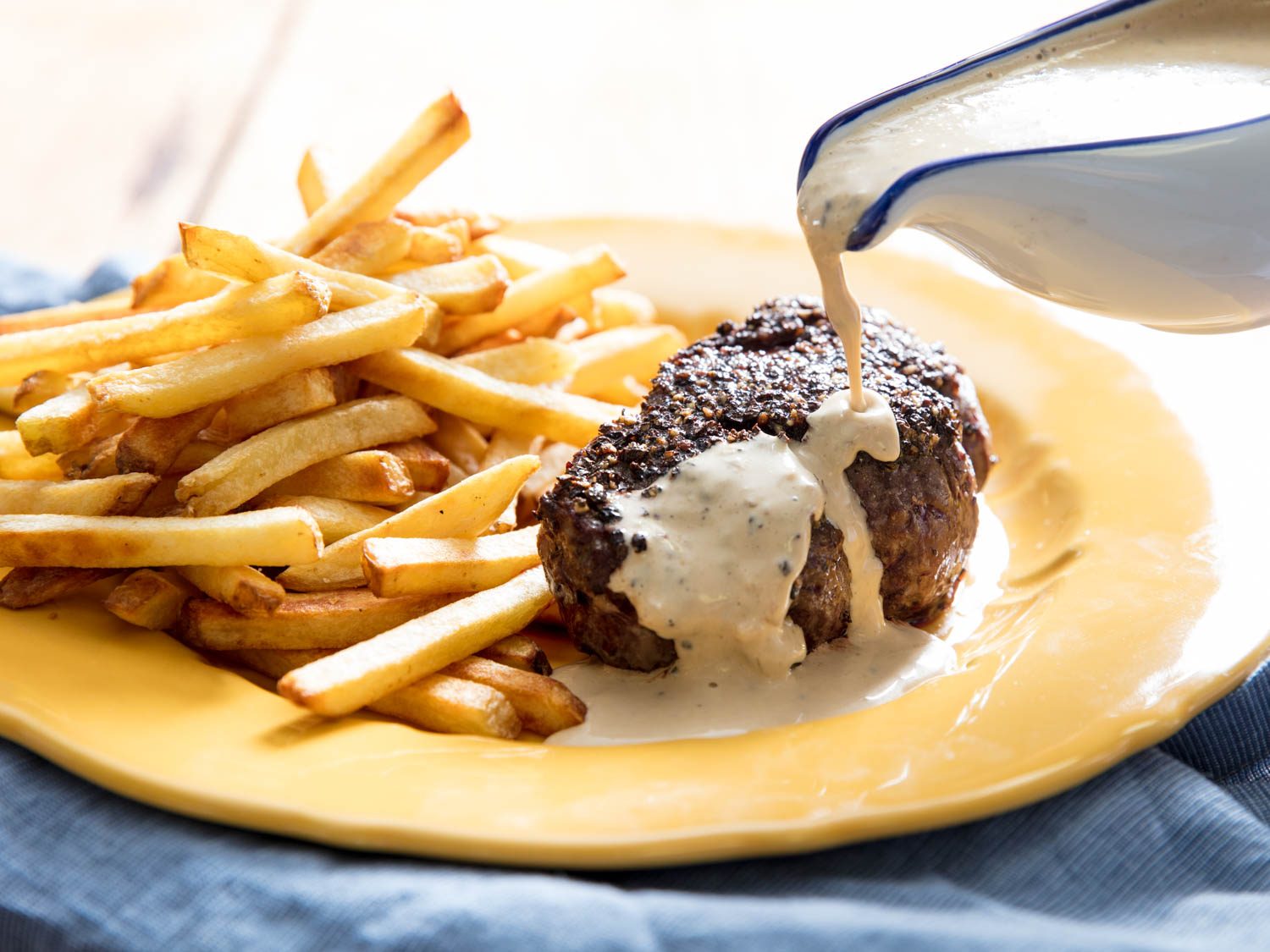
[Photographs: Vicky Wasik]
They say there are two sides to every story. This one began with two sides as well, both of them crusted in cracked peppercorns. But it ends with just one. And I want to convince you that it’s the only right one.
The story I’m telling today is about France’s classic steak au poivre—pan-seared, peppercorn-crusted steaks with a creamy pan sauce. More specifically, it’s about how to cook it. First, I want to assure you that it’s easy, despite the fancy-sounding name and legendary status. It’s more or less like any seared-meat-and-pan-sauce recipe, just with a spicy crust added.
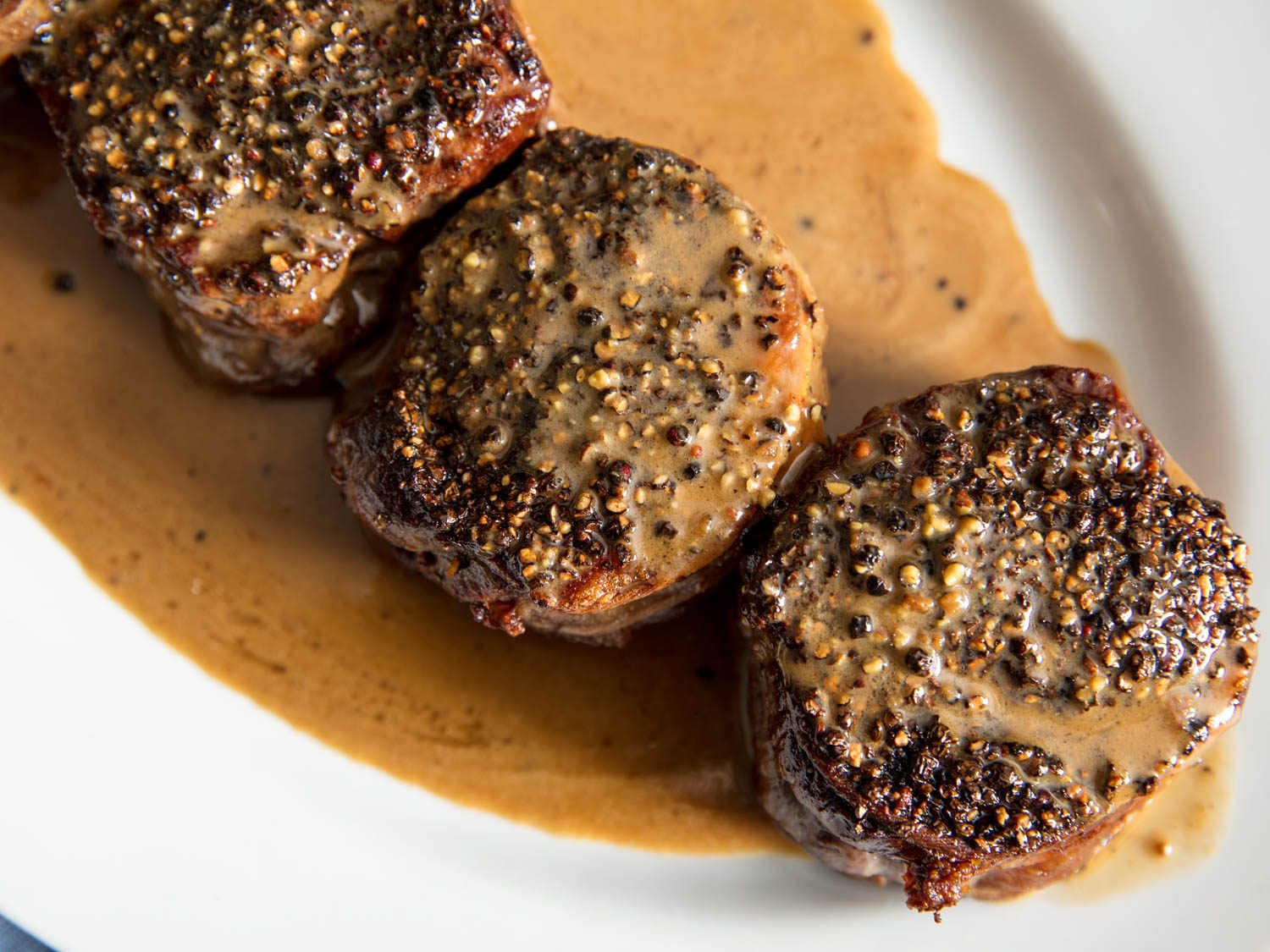
It’s that crust of peppercorns that needs the most attention. Most recipes call for pressing a layer of cracked black peppercorns into the top and bottom sides of each steak. You can make better steak au poivre, though, by encrusting the meat on only one side and leaving the other bare. The good news is, the recipe is even easier that way.
But that’s just one part of the story. Let’s start at the beginning.
Chapter 1: The Steak-Out
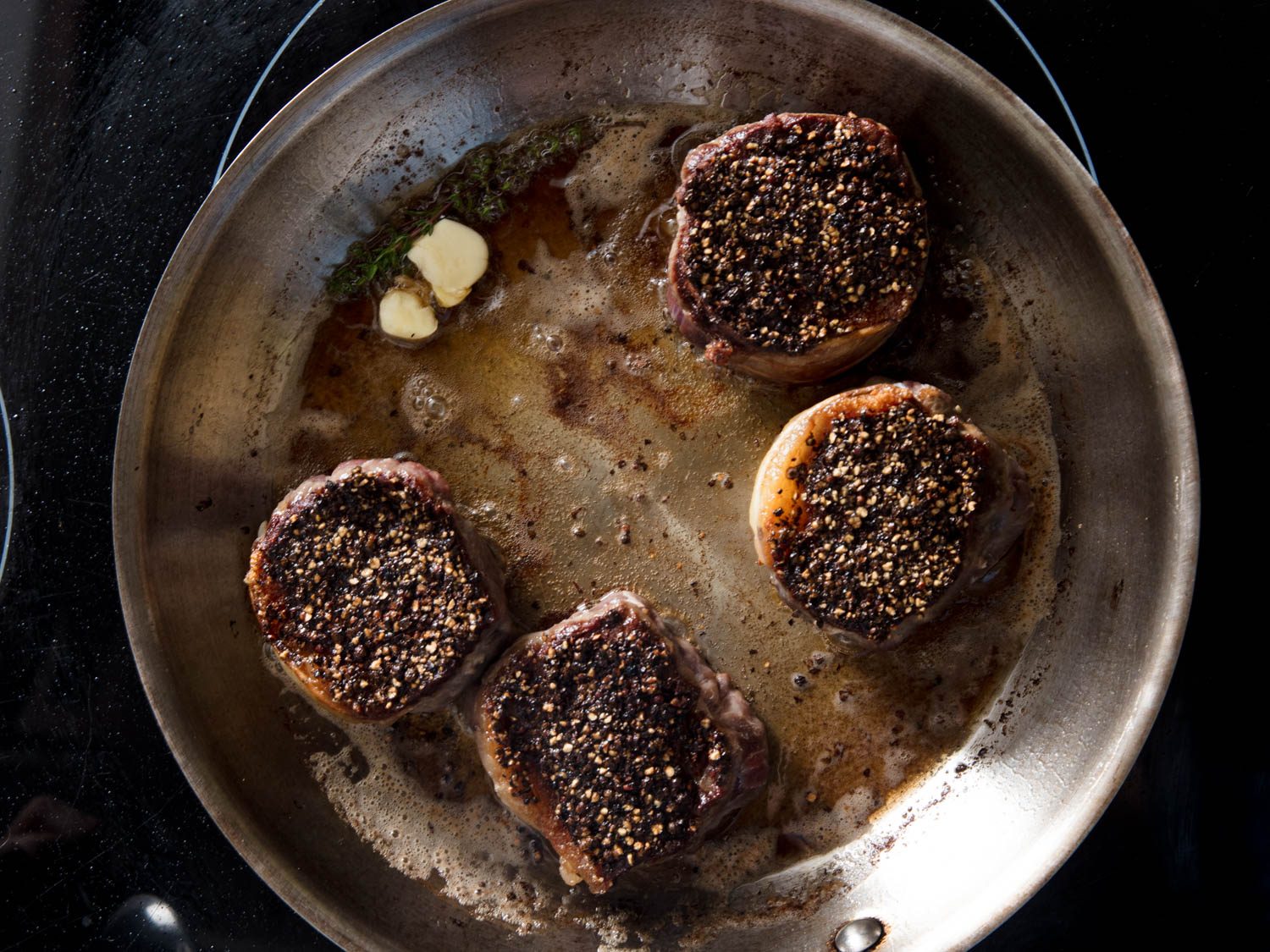
Filet mignon is the most classic cut for this dish, but medallions of other cuts, like the strip steak medallions here, work as well.
Steak au poivre starts with the steak. Most often, it’s medallions of filet mignon (also called beef tenderloin), but you can use any steak cut into a cylindrical, medallion shape—the photos in this story show medallions of both filet mignon and strip steak. The filet is supremely tender, which creates a better textural contrast with the crunchy peppercorns, but it tends to be less flavorful than most other cuts of beef.
Frankly, you could make this using a non-medallion cut, too. Peppercorns pressed into a big old boneless rib steak wouldn’t be too shabby.
Chapter 2: Children of the Peppercorn
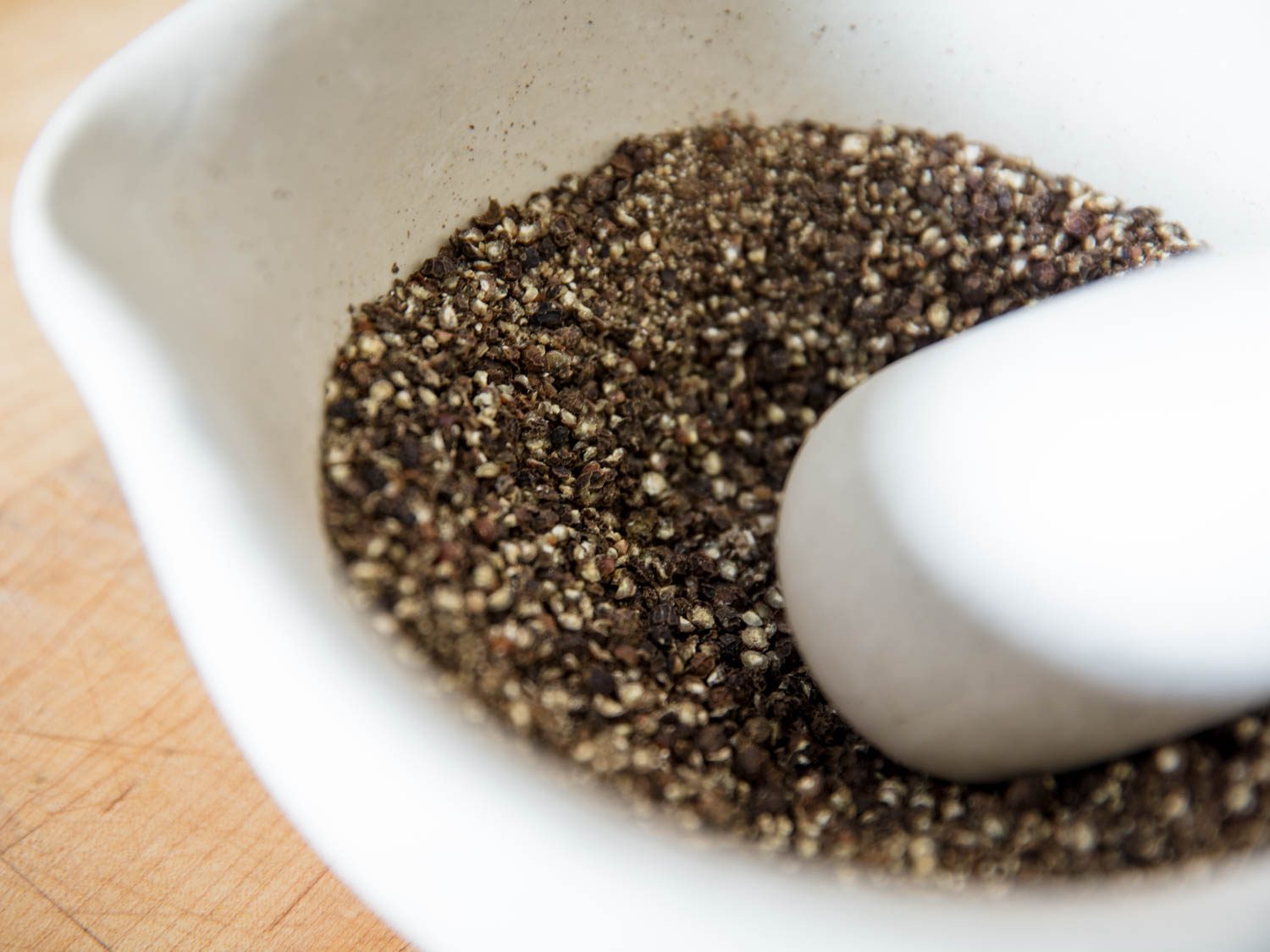
A mortar and pestle can be used to crack peppercorns, though they have a tendency to leap out as you crush them.
Steak au poivre requires cracking peppercorns, which can be a tedious task. The exact size of the cracked peppercorns is flexible, but you’re generally aiming for them to be broken into halves or quarters. Some will inevitably crack into smaller pieces than that, and a few whole ones may slip through the, erm, cracks.
There are a few ways to do it. Some pepper mills can grind coarsely enough to deliver nicely cracked corns; in our tests, the Magnum Unicorn was among the best at making coarsely ground pepper (though it stumbled on the fine setting). I managed to get good results from a mortar and pestle, but only after I broke the peppercorns down thoroughly enough that they stopped leaping from the bowl. If you own a meat pounder or large mallet, you can wrap the peppercorns in a clean kitchen towel and then hammer away at them. The rounded outer edge of a skillet can also be rolled over the peppercorns to break them down, but, once again, make sure you cover them first, or they’ll go flying all over your kitchen.
Once you’ve crushed enough peppercorns, you can spread them on a plate or in a rimmed vessel and press the steaks down into them. This brings up the question of pepper’s counterpart: salt. Salt and pepper are usually rained down onto meat at the same time, but steak au poivre complicates this a little, since you need the large pieces of pepper to adhere to the meat in an even layer. If you salt the meat first, then try to press the peppercorns into it right after, the salt acts as a barrier, preventing the pepper from sticking. You could do what French chef Joël Robuchon suggests, which is to apply the peppercorns first and then sprinkle the salt on top—but, as you can probably guess, that just creates the opposite problem, with the salt not sticking nearly as well.
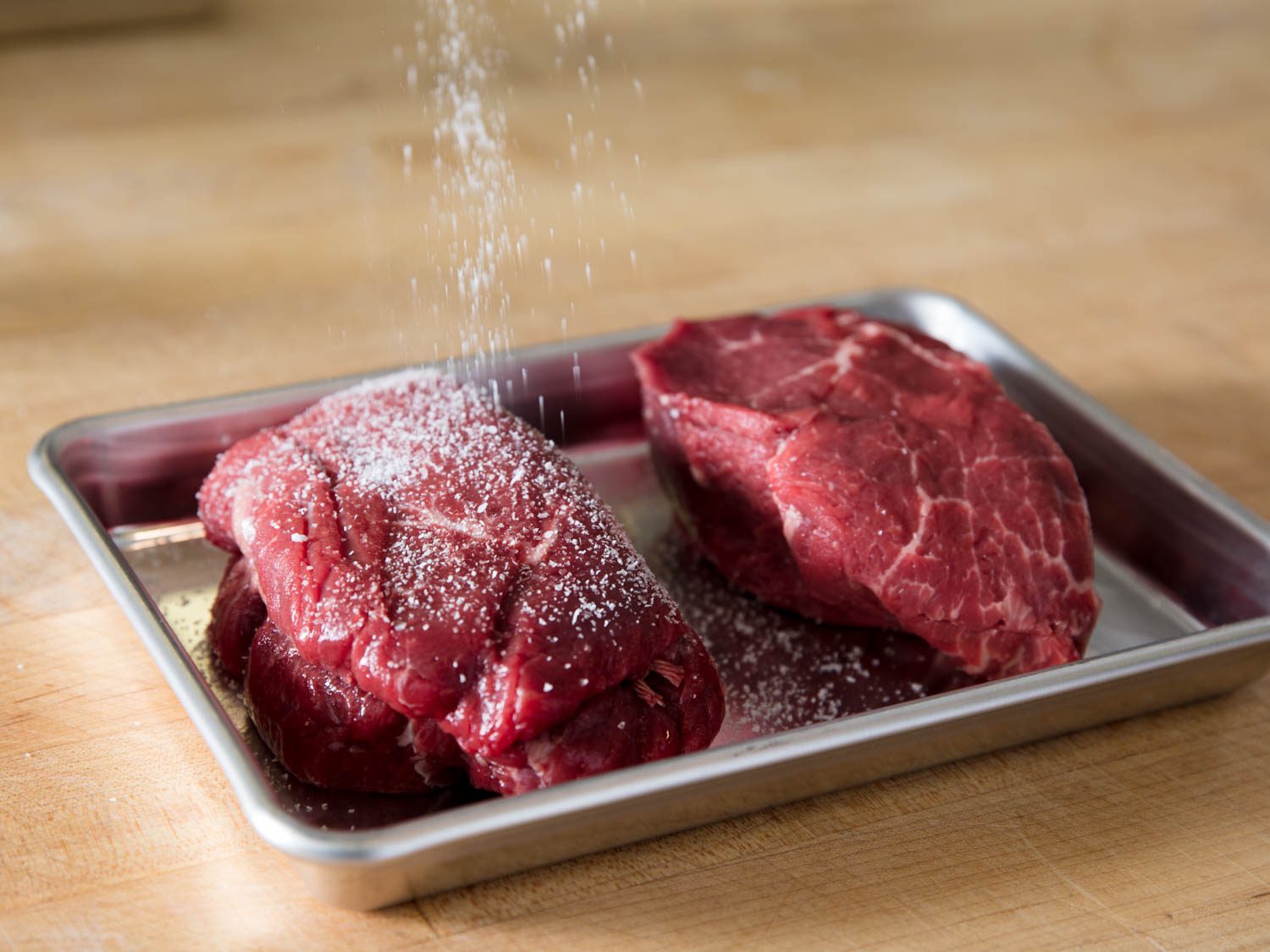
The solution is to salt the meat at least 30 minutes in advance, a technique called “dry-brining.” It’s something we like to do anyway, since it gives the salt time to draw out moisture from the meat, dissolve into that moisture, then get absorbed into the meat as it’s allowed to air-dry. Once the salt penetrates the meat, it dissolves muscle proteins, helping the meat retain more juices when it’s cooked. It’s the perfect technique for steak au poivre, because once the surface of the salted steaks is dry, you can press the peppercorns into it with no trouble.
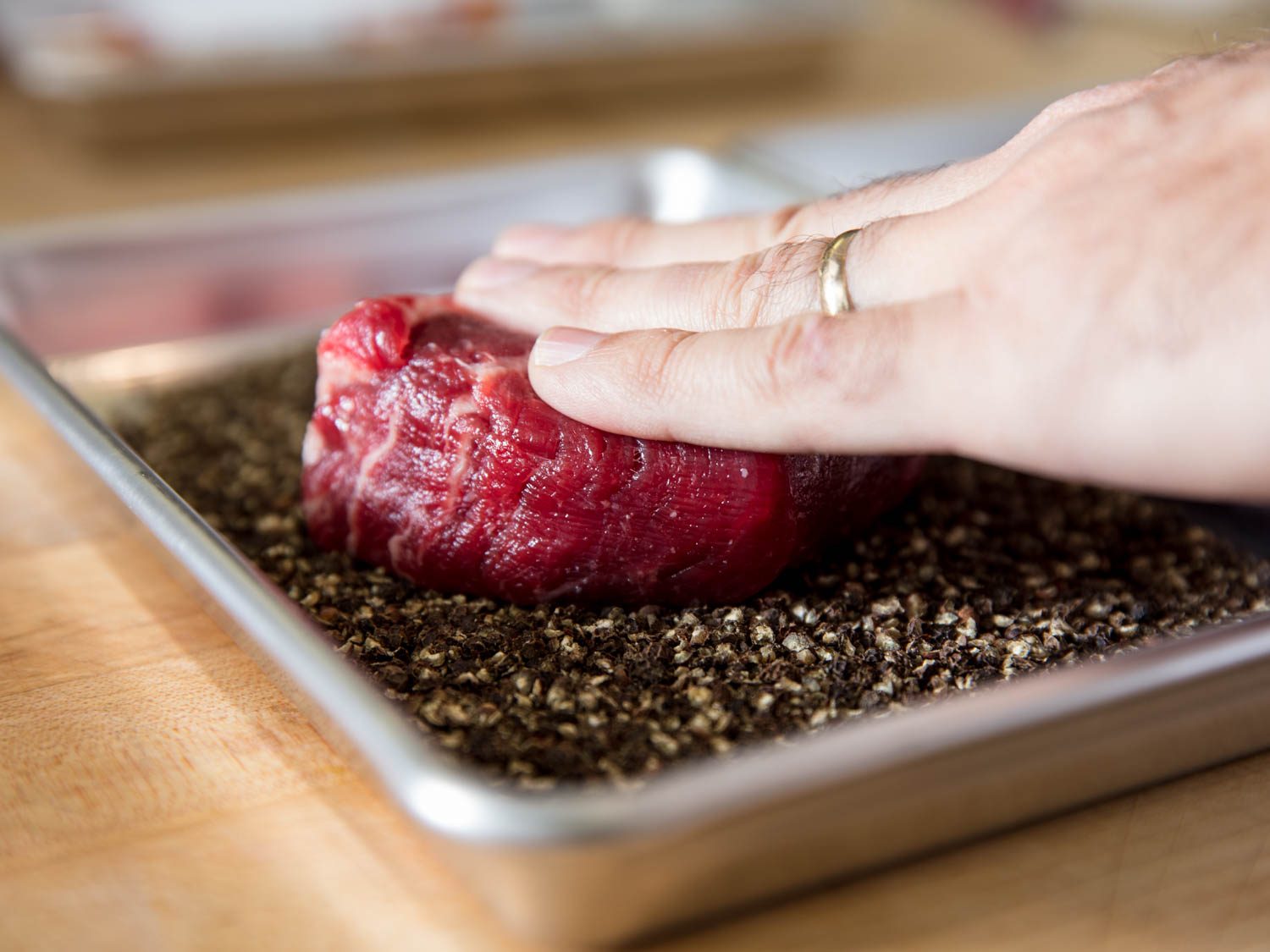
Steaks that have been salted in advance and allowed to air-dry can then be coated in peppercorns, with no adhesion issues.
Here’s where we get to the most interesting part of the story. Most recipes have you coat both sides of each steak in the peppercorns. I started my testing this way, but I didn’t like the result. The problem with coating the steaks on both sides is that the peppercorns act as a barrier, preventing you from ever properly searing the steak. That’s a problem for flavor, since we never get a deep sear on the meat itself—just deeply toasted spice. Even worse, we fail to develop the good fond (the browned stuff stuck to the bottom of a pan after searing) that’s essential for a flavorful pan sauce.

After realizing this, I switched to coating the steaks on only one side each, leaving the other bare. That way, we get a more deeply roasted flavor in the meat, thanks to the uncoated side that makes direct contact with the pan, and we get a better fond, which makes a better pan sauce.
Some of you may be thinking, “Yeah, but I like my steak au poivre peppery, and you just eliminated half the pepper in the recipe.” Except that I didn’t. I keep the remaining half of the cracked peppercorns, toast them in the skillet after cooking the steaks, and make the sauce from there. The result is an extra-peppery pan sauce, which makes up for the pepper left off the steaks.
Chapter 3: A Saucy Finish
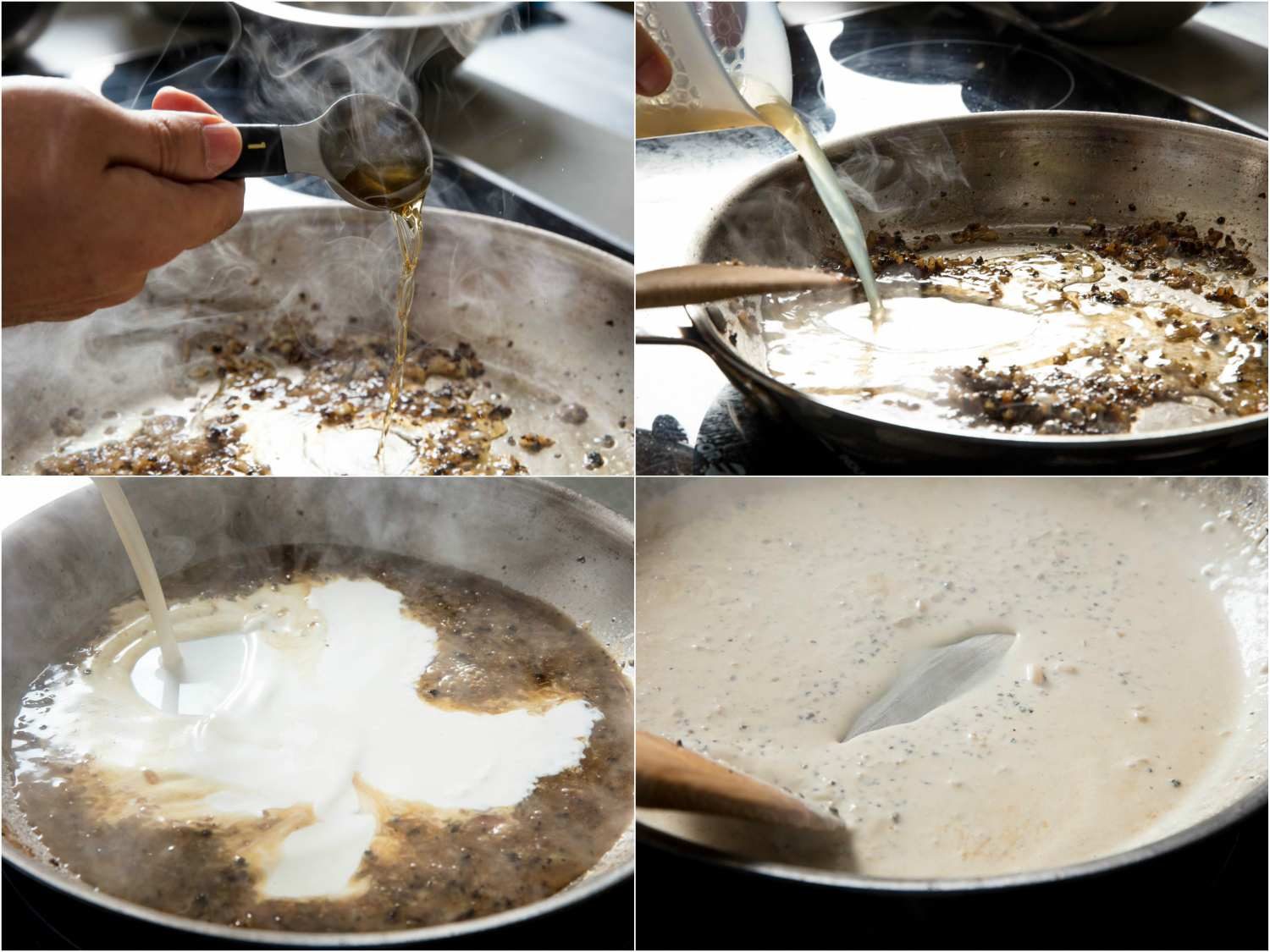
The sauce is the final stage in this little tale, and it’s incredibly simple to make. After toasting the extra peppercorns and sautéing some minced shallot, I deglaze the pan with brandy or cognac, letting it simmer until the strong alcohol flavor has cooked off. If you want to be flashy, you can flambé the booze, but you don’t have to, since simmering will also burn off the alcohol. Just be careful: If you’re working over gas, it’s easy to accidentally light the alcohol on the burner flame when it goes into the pan. That can be scary for those not ready for it, especially when the flames reach your upper cabinetry. To ward against a kitchen inferno, turn off the gas, add the alcohol, and relight the burner after that.
Next up comes stock. The best stock for this sauce is a well-made beef stock, but few of us have that kicking around at home, and store-bought beef stock is about as close to the real thing as murky water. If you have homemade chicken stock at home, that’s a far better choice than store-bought beef. If you don’t have a homemade option, then store-bought chicken stock will generally still be a better choice than a carton of beef “stock” off the supermarket shelf, since the chicken versions are usually made with more real meat than the beef ones are.
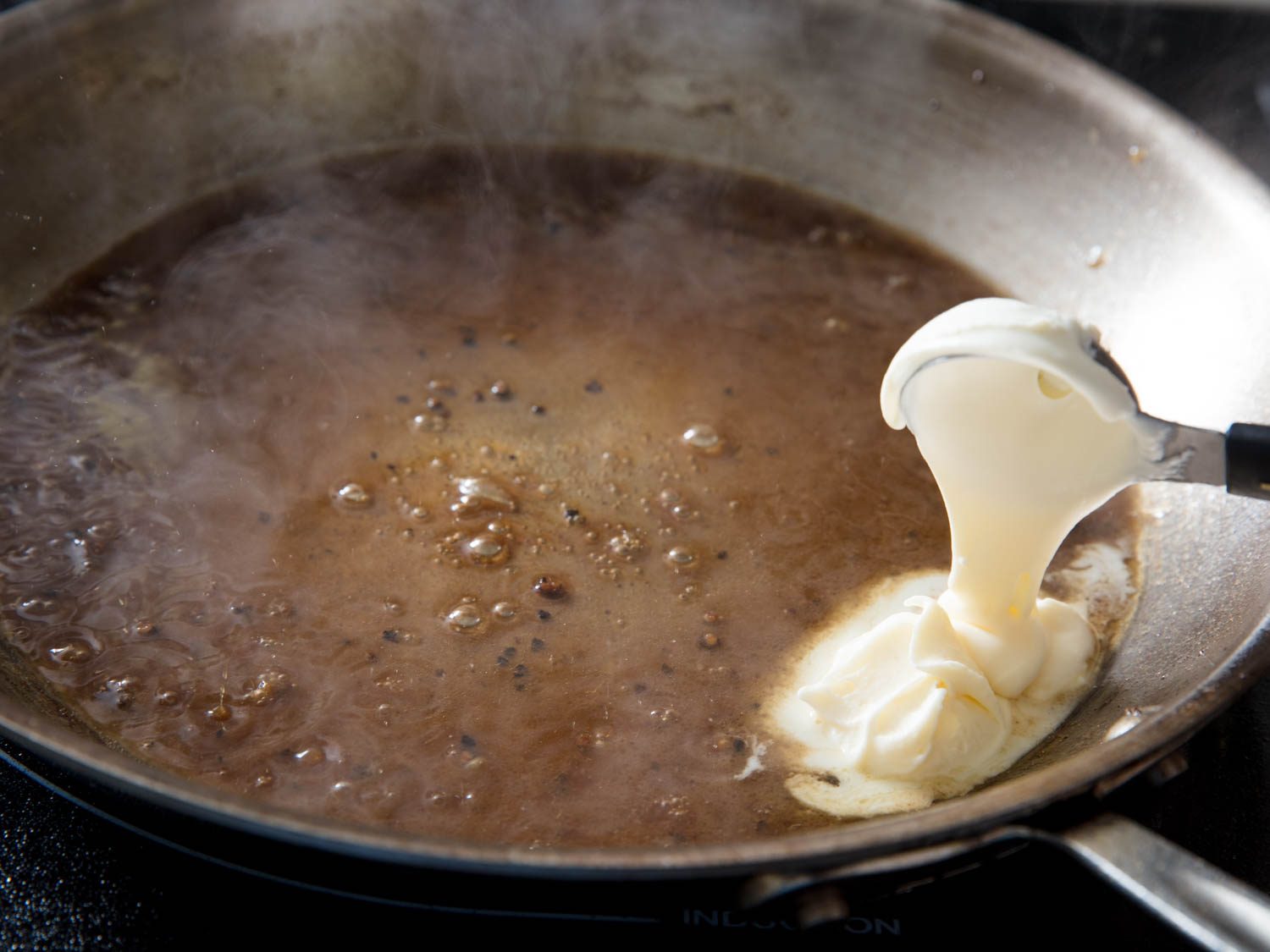
Tangy crème fraîche can be used in the pan sauce as an alternative to sweet heavy cream.
At this point, you can finish the sauce with either heavy cream or crème fraîche. I tested both and like both (and my recipe includes both as options). Heavy cream makes a milder sauce that allows the peppercorn flavor to shine through more, while crème fraîche produces a more complex sauce with a distinct lactic tang.
Reduce the sauce until it’s thickened to a spoon-coating consistency, whisk in some Dijon mustard, and it’s ready. It’s a recipe that makes sense and delivers deeply satisfying results, just like the best stories. There really shouldn’t be any other way.
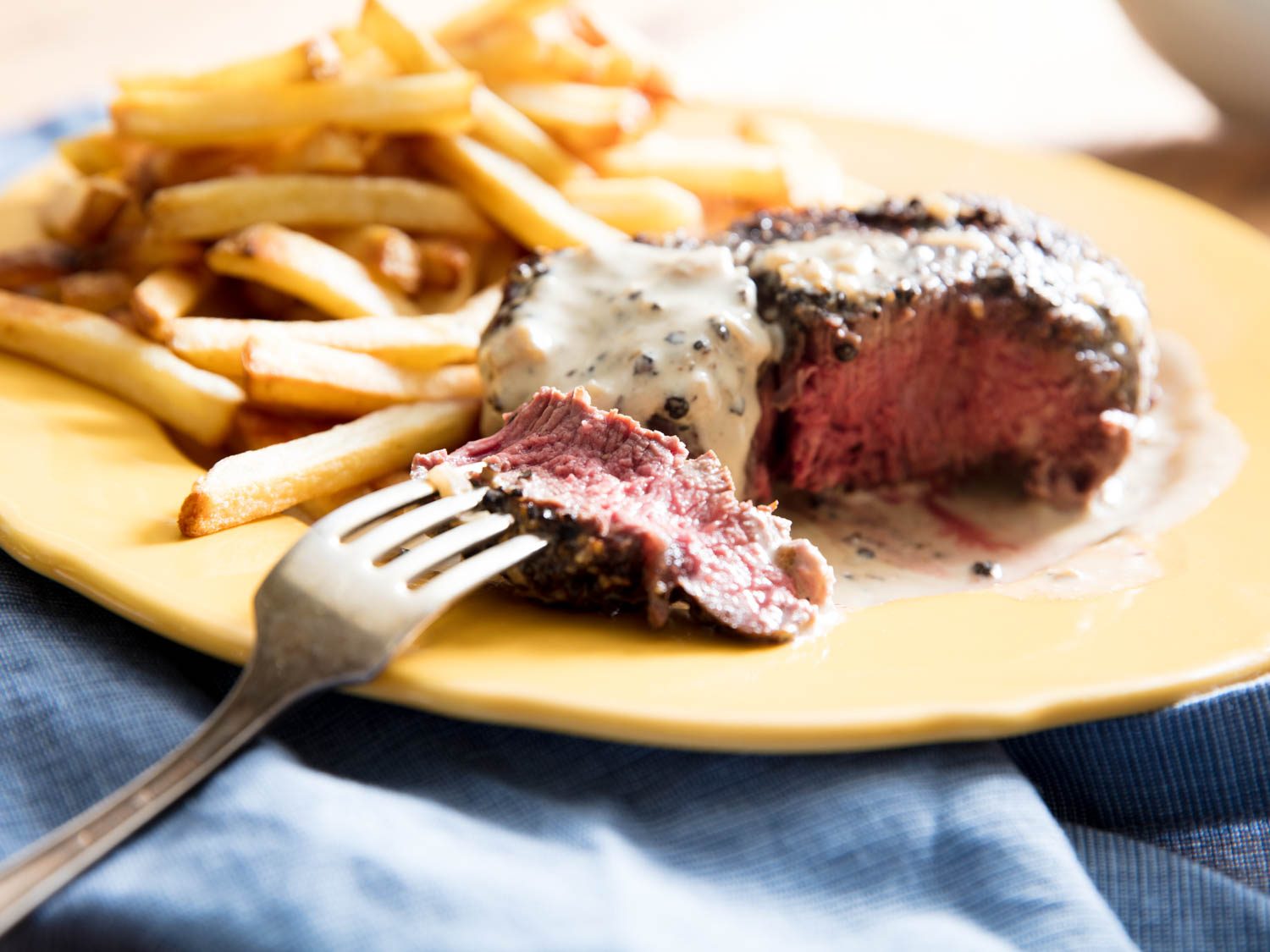
[ad_2]
Source link





